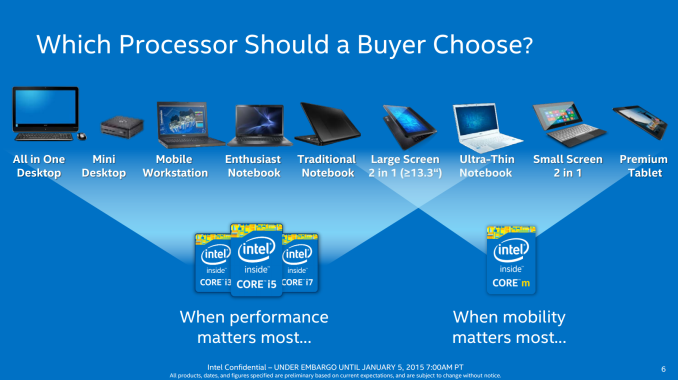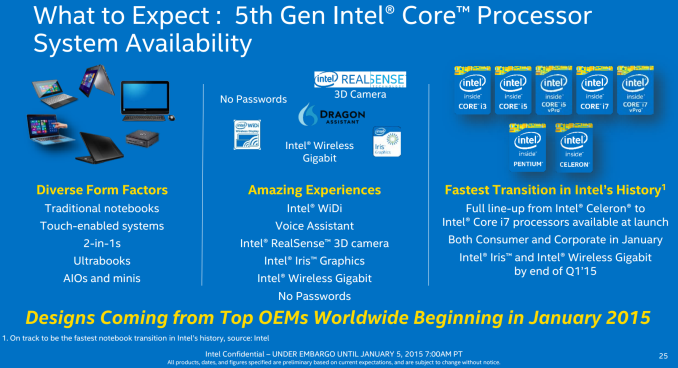Intel Releases Broadwell-U: New SKUs, up to 48 EUs and Iris 6100
by Ian Cutress on January 5, 2015 10:00 AM ESTFitting in With Core M
The staggered release of Broadwell is nothing new. Previous releases from Intel has seen them pick a particular market and aim at that first, whether it be tablet, mobile devices, ultrabooks or desktops, with the rest to follow. Core M, Intel’s 4.5 W ‘Broadwell-Y’ part, has been in the market for over a month with designs such as the Lenovo Yoga 3 Pro, although the number of SKUs available as well as worldwide distribution has been relatively slow, with the designs featuring Core M being expensive in terms of casual computing and more premium upgrades. Broadwell-U changes this by opening up the power envelope, and as such Intel sees the market at follows:
The Broadwell-U processors from Intel are aiming to give enough performance from AIO desktop systems to mini desktops, premium mobile applications all through to large 2-in-1s. There is some overlap with Core M, particularly with the 7.5W cTDP down elements of the range, but the interesting element will be pricing. The Celerons come in around $100, with the Pentium at $160, but then it gets expensive for Broadwell-U. $275 to $315 covers all the i3 and i5 parts both at 15W and 28W, ending with $393/$426 for the i7 parts. Further to my efficiency comments above, on paper at least the i5-5350U or i5-5250U would seem the most interesting processors of the bunch.
Release Dates
In our conference call with Intel, it was clear that these CPUs are shipping to their partners today. Throughout CES there will be a number of manufacturers announcing their products, and as per the norm Intel allows the partners to introduce their own products, rather than showing examples of where Broadwell-U fits in. However, because Broadwell-U is designed to be pin-compatible with Haswell-U, we might see some manufacturers purely re-releasing some of their designs with the newer CPU and a firmware update. Nevertheless, Intel is expecting OEM systems with Broadwell-U to start shipping in North America within the month. Designs with Iris graphics, or those featuring Intel based WiGig connectivity, will be more towards the end of Q1. Overall Intel is tracking ‘hundreds of designs’ involving Broadwell, indicating that it will be a significant push to bring 14nm to the market.












85 Comments
View All Comments
DigitalFreak - Monday, January 5, 2015 - link
They do, but it's not usually a major update.R3MF - Monday, January 5, 2015 - link
the 15W i5 chips will be the ones found in the vast majority of ultrabook models released by the vast majority of the ultrabook manufacturers.to me, the interesting question is whether the 48EU model will be popular, or whether the bulk of the above will be taken up by the 24EU models...?
will a Core i5-5300U** be sufficient to run Total War: Attila at low settings at 1600x900?
** 2 / 4 2.3 2.9 2.7 24 300/900 1600/1600 3MB 7.5W Yes $281
kspirit - Monday, January 5, 2015 - link
Well, my best bet is that the xx00 (24EU) parts will be the most popular just like Haswell ones were, because if I remember correctly these were the same prices for the equivalent Haswell parts. I only ever saw the 28W TDP parts in MacBook Pro and Zenbook Infinity, which are the very highest end ultrabooks. You're right when you say that i5 (and 24EU) parts will be the most common, and I don't think the performance increase will be noticeable at all...romrunning - Monday, January 5, 2015 - link
It used to be that you could generally equate an i7 with 4 cores. These i7 Broadwell-U CPUs all seem to be 2-core, so it just seems to muddy up the issue for the consumer. Oh well... maybe these were all meant for OEM designs anyway.drothgery - Monday, January 5, 2015 - link
Mobile i7s have been dual core from the very beginning. Real quad-core mobile parts didn't show up until the highest-wattage mobile Haswell parts ...RussianSensation - Monday, January 5, 2015 - link
What do you mean? There have been mobile quad-core HT i7s for 4 years now, with Sandy and Ivy:1. Core i7 2630QM - Jan 3, 2011
http://www.notebookcheck.net/Intel-Core-i7-2630QM-...
2. Core i7 3635QM - Sept 30, 2012
http://www.notebookcheck.net/Intel-Core-i7-3635QM-...
There have been many faster Sandy and Ivy quad-core i7s than the 2 models I specifically quoted. It is very misleading to call a dual-core HT CPU as an i7, when really that has always been an i3.
TiGr1982 - Monday, January 5, 2015 - link
Even earlier than that, for example, the first gen Nehalem (45 nm) Core i7-720QM was released in Q3 2009 and was a 4 core and 8 thread CPU:http://ark.intel.com/products/43122/Intel-Core-i7-...
However, these were 45 W parts; full wattage parts are a different story.
LukaP - Friday, February 20, 2015 - link
Those are all QM parts. Those have always been 4core. This article is about the Broadwell-U parts, which are made on a 2core die.drothgery - Monday, January 5, 2015 - link
Sorry. The QMs have been around for longer than I remembered, but dual core mobile i7s were around from the very beginning, and the quads have always been largely restricted to mobile workstation-type laptops and the occasional gaming laptop.psychobriggsy - Monday, January 5, 2015 - link
Very small dies, even for the 48 EU chip.Seems that the 48 EU chips will match the GPU performance, on paper, of AMD's Kaveri. This should allow for some interesting GPU comparisons in reviews.
The prices are not very pretty, and where are the quad-core chips? The cores are tiny on 14nm. Almost irrelevant. Modern CPUs are more like GPUs with CPUs tacked on.